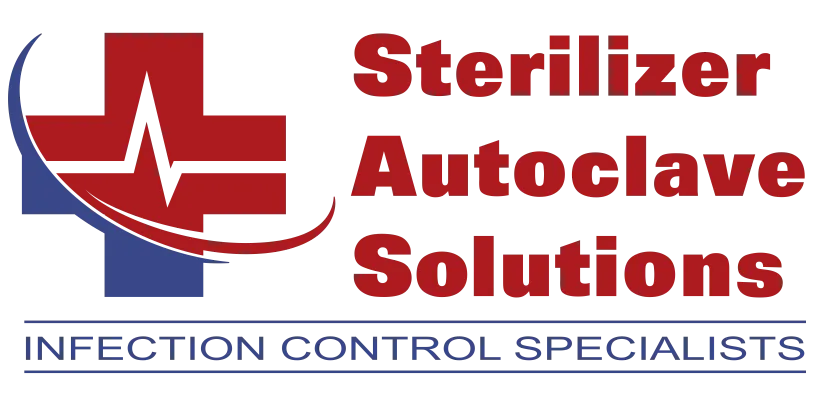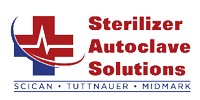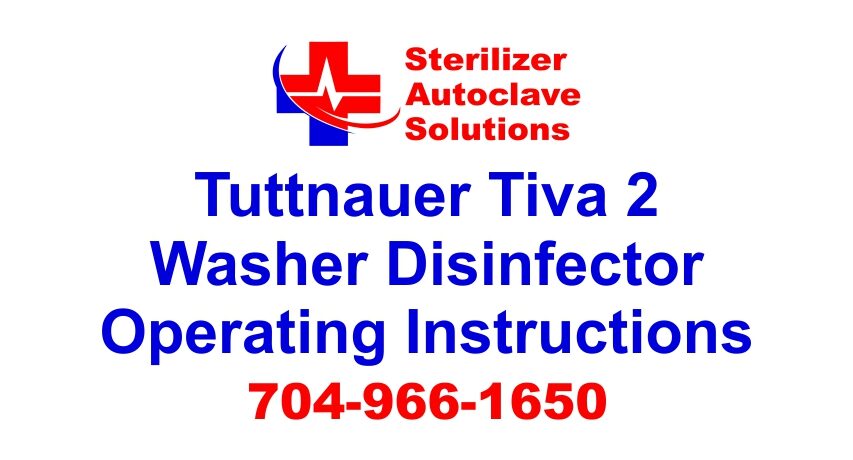Tuttnauer Tiva 2 Washer Disinfector Operating Instructions Leave a comment
Our Tuttnauer Tiva 2 Washer Disinfector Operating Instructions is a quick guide to cover the basic operation of this amazing thermo disinfector. In this article we will cover commissioning instructions, before use, programs, starting the machine, and display.* And if you just want to talk to someone, call our Free Tech Support at 704-966-1650 Option 3.
Using the Machine
Before starting the machine, the operator in charge must have read and understood this whole manual, in particular the information on safety. Furthermore, before starting work, check that the machine is in order and that all parts subject to wear and deterioration are fully efficient.
Commissioning Instructions
These control operations (reported below) are performed to check if the machine works properly and should be performed when the machine installation is completed.
1 – Open the tap that supplies water to the machine
WARNING. The water should NOT flow into the tank; otherwise the water loading solenoid valves (in the lower compartment of the machine) are dirty or blocked due to long storage in the warehouse and therefore they must be cleaned. Check that there are no water leaks in the pipe fittings.
2 – Check that the suction tubes (located in the lower part of the machine) within the corresponding containers/tanks containing the liquids provided (detergent, neutralizing, and/or others), are correctly inserted.
3 – Using the main circuit breaker, supply power to the machine.
4 – Check that the water supply flexible hoses are properly connected.
5 – Start the machine using the ON-OFF switch (#1 below)
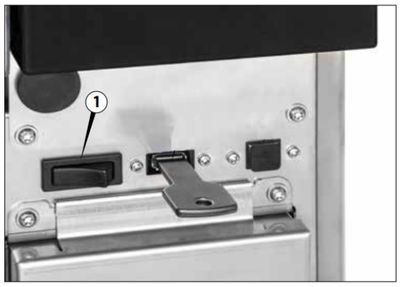
6 – At the beginning of the first cycle check the level probes of the liquid suction tubes (detergent, neutralizer and/or other): pull one tube at a time out of the container and check if the corresponding alarm flashes on the display, indicating the need for liquid refilling.
7 – After running 3-4 washing tests, clean the water filters placed in the lower compartment of the machine.
8 – Check that the drain trap does not show water leaks and is firmly secured to both the machine and the drain.
9 – Check if the pumps correctly suck washing liquids. To do this, check that the liquid rises along the tube connected to them.
Before Use
The Tuttnauer Europe b.v. thermodisinfector can be used for cleaning and disinfecting:
- Medical instruments.
- Keys, trays, containers.
- Hollow instruments, e.g. suction cannulas, fixing them to the appropriate supports, using the suitable adapters.
Emergency Door Release
In the event of a blackout, or any other need in which it becomes difficult to open the thermodisinfector door, there is a manual emergency release that can only be activated if the door cannot be opened normally.
HAZARD. If the emergency release is used while a program is running, very hot water and chemicals may leak. Therefore, there is a danger of burns, scalding and irritation.
To access the emergency release:
- open the lower door of the machine with the key;
- remove the rubber cap (see #4 below);
- a plastic cable can be seen inside the hole.
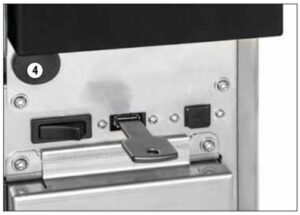
1 – Simply pull this cable manually and the door is released.
2 – Re-insert the cap after the operation.
3 – In case of program interruption, proceed with a new treatment of the load.
Preparing the Load
- WARNING – The maximum weight that the open door can withstand is 12 Kg.
- WARNING – The maximum volume available is 0.065 mW or 65 L.
- WARNING – The maximum volume of the basket is 0.025 mW or 25 L.
The instruments to be washed must be placed on the relative basket, making sure that they do not overlap on one another.
- Empty any residual liquids from the containers before inserting them into the tank, thoroughly washing any residue, e.g. disinfectant solutions.
- Insert the individual instruments in the appropriate supports or baskets and never directly into the base basket.
- Make sure that the instruments do not come out of the containers.
- Make sure that the instruments do not hang from the grid bars.
- Insert the hollow instruments into the appropriate injectors.
- Insert the other instruments into the adapters with silicone insert.
- The rinse arms must be free to rotate.
- The cleaning quality depends on the correct loading of the instruments.
- Position container-shaped objects so that liquids can flow easily and, if possible, place tall and heavy tools in the centre of the trolley.
- Components with special geometries must be arranged so as to allow the water to flow out.
- Introduce only suitable steel instruments, resistant to corrosion.
- Introduce only plastic components thermostable up to 95°C.
- To prevent possible corrosion, we recommend using only stainless steel instruments and tools, suitable for washing.
- Nickel-plated and chrome-plated and/or aluminium instruments and tools may not always be suitable for machine treatment. They require special process conditions.
- Objects made completely or partially of plastic must be resistant to high temperatures.
- Before loading the machine, remove substances such as composites, cement and amalgam in compliance with current directives.
- Transmission instruments with fibre optic rod are considered resistant, while fibre optic beams may be subject to premature wear.
- If possible, disassemble the modular instruments following the manufacturer’s instructions and treat the individual parts separately.
- Treat small instruments and parts in special inserts or closable baskets.
- Before the automatic treatment, check that the lumen and hollow body instruments can be treated internally and remove any obstructions.
- Carefully place the load in the supports.
- Objects must not be put inside each other nor cover each other. Do not place objects so close to each other that they cannot be washed properly.
- Arrange the load so that all surfaces can be reached by the washing liquid. Otherwise they will not be cleaned!
- Place the objects so that the liquids can flow out without hindrance.
- Place tall or heavy objects in the center of the basket.
- When arranging the load, make sure that the spray arms are not blocked by the load itself.
- Distribute the objects evenly in the baskets.
- After the treatment the transmission instruments must be cleaned according to the manufacturer’s instructions.
- After the treatment, before reusing the transmission instruments, check that they work properly, e.g. by spraying liquid in the sink.
When the base grid is used together with the injectors, make sure to push the grid all the way back against the rear wall of the tank, so that the injectors can be perfectly fixed on their connection tube at the bottom of the tank itself.
Summary of the Basket Loading Procedures
Instrument: Knobs – Insert Type: Basket
- Fill the basket arranging the instruments upside down in the appropriate holes;
- Insert the basket in the tank up to the stop;
- Close the door, start the program.
Instrument: Trays – Insert Type: Tray Holder
- Fill the insert by arranging the trays in the spaces provided;
- Insert the insert in the basket;
- Insert the basket in the tank up to the stop;
- Close the door, start the program.
Instrument: Surgical – Insert Type: Instrument Holder
- Fill the insert by arranging the trays upside down in the spaces provided;
- Insert the insert in the basket;
- Insert the basket in the tank up to the stop;
- Close the door, start the program.
- HAZARD. Be very careful when inserting pointed or sharp instruments. Always insert the instruments starting from the bottom, and possibly wearing protective gloves. Perforated baskets and supports do not provide protection against pointed and/or sharp instruments.
- WARNING. Failure to follow these recommendations may cause injury. Pay the utmost attention when loading/unloading the instruments to be washed.
Treatment of Dental Instruments
- WARNING. Insert only instruments suitable for automatic treatment in thermodisinfector devices, according to the manufacturer’s instructions. In particular, follow the information provided by the same manufacturer.
- Despite compliance with the manufacturer’s instructions, in case of damage or alteration of the instruments, the responsibility will be borne by the instrument manufacturer.
Correct program
Before starting the treatment, check that:
- The external surface of the instruments is clean of material residues (E.g. dental cement, etc.).
- The air and spray channels must be clean.
- Finally, carry out a test.
Care of the instruments
Major manufacturers recommend drying the spray/air/water channels immediately after cleaning and disinfection using clean compressed air with suitable maintenance products.
- It is recommended to follow the specific instructions.
Treatment of Ophthalmic Instruments
– Only insert instruments designed for automatic treatment in thermodisinfector. Carefully follow the instructions provided by the instrument manufacturer.
– Do not insert instruments intended for interventions on the optic nerve and which come into contact with the retinal tissue.
– In case of damage or alteration of the instruments despite compliance with the manufacturer’s instructions, the responsibility will still be borne by the instrument manufacturer.
- WARNING. The treatment of ophthalmic instruments requires the use of purified water.
Comply with the following for automatic treatment:
- Use a slightly alkaline liquid for cleaning. Use a citric acid-based neutraliser for neutralisation. Never use liquids for rinsing.
- Rinse the hollow instruments after the application and check that the purified water passage is free before the automatic treatment.
- Insert the hollow instruments into the rinse bar, specially designed for this use.
- Make sure that no deposits form on the instruments.
- Dry the hollow instruments with compressed air after the treatment in order to remove all residue humidity.
- Follow the manufacturer’s instructions with regard to the maintenance of instruments/accessories for loading.
Tiva Basket Support Lanes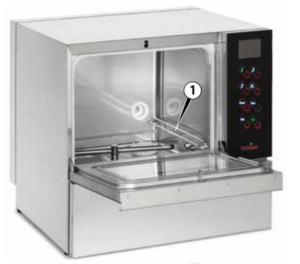
Tiva Basket Insertion and Extraction Direction 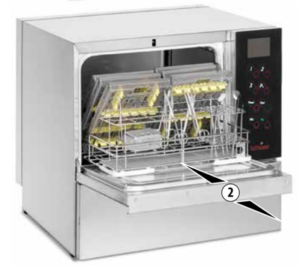
Programs
The machine leaves the factory programmed with three separate use programs already entered in the settings menu.
To select the programs available, use key 1, 2 or 3 (on the control panel shown below) depending on the most suitable program for the level of dirt of the load.
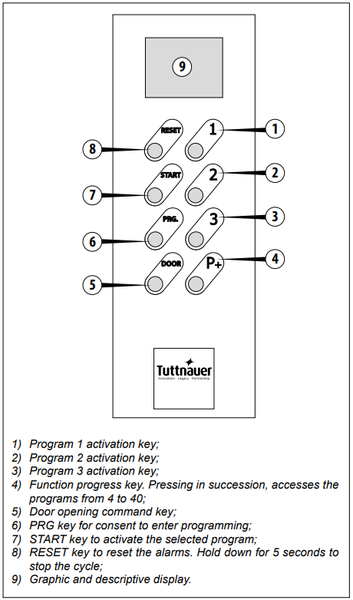
The following table shows the correct programs for each type of load.
| Program | Use |
|---|---|
| SHORT Program 1 | Washing and disinfection program for the treatment of instruments with normal dirt, with times and dosages lower than Program 2. |
| STANDARD Program 2 | Filling of the dosing system with additive for final rinsing or neutralizing after filling or replacement of the container. Program tested and certified according to EN ISO 15883. |
| INTENSIVE Program 3 | Washing and disinfection program (not EN ISO 15883 certified) specific for the treatment of instruments with stubborn dirt. |
| Rinse Cold Water | For rinsing water and salt solution of a particularly dirty load, e.g.: to eliminate coarse dirt or disinfectant residues before treatment and to prevent dirt from drying or the formation of limescale until a complete program is started. |
| Drying | Additional Drying |
Program structure:
- Drain – It is used to empty the washing tank.
- Pre-wash – Pre-wash is necessary to eliminate coarse dirt and foamy substances.
- Wash – Depending on the load, washing normally takes place at 45°C – 65°C, adding the appropriate detergent.
- Rinse – The rinsing operation eliminates and neutralizes the chemicals of previous washes.
- Disinfection – To prevent the load from being subject to corrosion or patinas, purified water (if available) should be used during the disinfection phase.
- Drying – Sufficient drying reduces the risk of corrosion caused by the residual humidity on the load.
Starting the Machine
After checking the integrity and full efficiency of the machine, proceed with start-up.
- Power the machine using the main circuit breaker.
- Start the machine using the ON-OFF switch (Fig. 1) and open the door (key 5 Fig. 3) to introduce the baskets.
Before starting the program
- Check that the filters, positioned on the bottom of the tank are perfectly clean. Clean them, if necessary.
- The nozzles of the upper and lower spray arms must be free and clean.
- Basket and products must be arranged correctly.
- The rinse arms must be able to rotate freely. The machine constantly monitors the rotation speed during the program.
- Liquid containers must be sufficiently filled. Check for any messages on the display before starting the program.
Closing the Door:
- Introduce the basket and load the instruments.
- Close the door and push it until the lock is activated. The door can be unlocked and opened at any time before the program starts, by pressing the key (5 Fig. 3).
Selecting the Program:
- To select the programs available, use key 1, 2 or 3 on the control panel (Fig. 3).
- Choose the most suitable program depending on the level of dirt on the products to be washed.
| Program 1 "SHORT" | This is a washing and disinfection program for normal dirt, sufficient for daily used instruments. |
| Program 2 "STANDARD" | This is a program tested and certified according to EN ISO 15883 with filling of the additive dosing system for final or neutralising rinsing |
| Program 3 "INTENSIVE" | This is a specific program designed for treating instruments with stubborn dirt. |
Starting the program
- WARNING. Inattentive and superficial use of electrical devices may lead to risks for the operator.
- Tuttnauer Europe b.v. is not liable for possible damage caused by uncontrolled use of the device.
After selecting the program with relative key, the display shows the selected program and the operating time and temperature.
- To start a program, press the START key (Fig. 1).
Program Execution
- Once the program has started, its progress can be followed on the display. The display shows the program phases during operations.
Pre-Wash
- Pre-wash is carried out with cold water (optional softened water) and without liquids. It mechanically dissolves encrusted organic materials and all proteins on the surface of the instruments. Avoid too high water temperatures.
Wash
- It is the actual cleaning cycle. The cleaning tank heats up until it reaches the specific temperature for the selected program, a temperature that remains stable for the holding time. The cleaning liquid is automatically introduced before the start of the holding time.
Rinse
- Rinsing is carried out with cold water, if the machine is equipped with the second pump (optional) it is possible to carry out the neutralisation cycle by introducing neutralising liquid which is designed to reduce the alkalinity and clean the instruments from residues soluble in acid, e.g. limestone and rust.
Disinfection
- Thermo-disinfection is carried out with water, if the machine is equipped with the second pump (optional) it is possible to introduce the rinse aid to carry out the neutralization cycle which is designed to reduce the alkalinity and clean the instruments from residues soluble in acid, e.g. limestone and rust.
Drying
- The instruments are dried internally and externally with filtered hot air. Good drying reduces the risk of corrosion caused by the residual humidity on the load.
- Instruments with a very small internal diameter must be dried further.
- WARNING. The program can be interrupted at any time. However, it must be remembered that once interrupted, it must restart from the beginning. Only if it is interrupted in the drying phase can the cycle be considered completed successfully. The instruments must be dried.
Program End
The message «Successfully completed» on the display indicates that the program has been carried out correctly.
Unlock the door by pressing the key (5 Fig. 3) and open it.
Open the door immediately after the end of the program to avoid condensation forming.
Check the results at the end of the cleaning process. The instruments must be completely clean and dry.
Hollow instruments with a small internal diameter must be dried further with air.
- Check hollow instruments and retreat them if necessary.
- The hole (lumen) of hollow instruments must be free.
- The injectors must be correctly placed on the connection tube in the cleaning chamber.
- The nozzles and connections to the base grid must be firmly fixed.
If these checks are positive and the program has been carried out without interruptions or malfunctions, the load has been successfully cleaned and disinfected.
Extracting the load
At the end of the program and when extracting the load:
- Do not force to open the door to avoid damaging the device and/or the leak of toxic steam.
- Particularly large instruments can be very hot at the end of the program. Allow instruments, containers and inserts to cool down before removing them.
Failure to follow these recommendations can cause burns.
Display
The LCD display shows the status of the machine. The images show the various phases and the current operation. For example, if the machine is loading water, the display will show the image of the tap, of the water flow meter and of the water being loaded: if water is purified droplets will be light blue, if water is cold droplets will be blue and if water is hot they will be red. The images are animated, to show how the current operation evolves.

Description of the display
- The number of the running program is displayed (e.g. P02 = program 2);
- It displays the phase the machine is running. If the machine is going to run a wash cycle it will display the writing «Washing». When the machine displays an alarm that space background turns red and the message shows the number of the alarm and a brief description;
- The A0 value is displayed during disinfection;
- Several animated images showing the current status of the machine are displayed;
- The elapsed phase time from the moment the temperature set for the phase (see 12) has been reached is displayed;
- Bar indicating the progress of the program; if the program is ending, the bar will be almost entirely green;
- The temperature measured by the PT1000 probe, placed after the air heater, is displayed to indicate the temperature of the air entering the tank;It displays the temperature measured by the PT1000 probe placed in the tank. This is a control probe;
- It displays the temperature measured by the PT1000 probe placed in the tank. This is a control probe;
- It is the display of the temperature measured by the PT1000 probe placed in the tank. This is a work probe. The temperature detectable by the two probes (control and work) must not differ from each other by more than 2°C;
- Time for which the device should maintain the set temperature (see 12);
- Phase of the program;
- Temperature set for the current phase;
- Date and time is displayed with the machine in stand-by.
Messages on the display
During washing, several messages may be displayed:
- Product 1 liquid reserve (meaning that the liquid inside the product 1 tank is finished and must be replaced);
- Product 2 liquid reserve (meaning that the liquid inside the product 2 tank is finished and must be replaced);
- Product 3 liquid reserve (meaning that the liquid inside the product 3 tank is finished and must be replaced).
These alerts are alternated with the description of the current phase.
When the cycle has finished the following message appears:
«Program ended»; now the door of the «clean zone» is unlocked and the trolley with the washed instruments can be unloaded.
If the program is interrupted for one of the following reasons:
- when the Reset button is pressed,
- because of an alarm,
- power supply failure,
the display will show the message «Program interrupted no disinfection» (the words «no disinfection» only appear if the running program has not yet completed it).
The central part of the display also shows the message: «In 10 seconds the program will resume its operation or press and hold the reset button for 10 seconds to definitively stop it».
If the RESET button is pressed for 10 seconds, the program stops.
If the RESET button is not pressed, after 10 seconds the machine resumes the program previously interrupted.
If an alarm occurs, the machine stops until the problem is solved.
Display screens
After starting the machine (following above directions), the display will show the following images indicating step-by-step the operations in progress.
1- 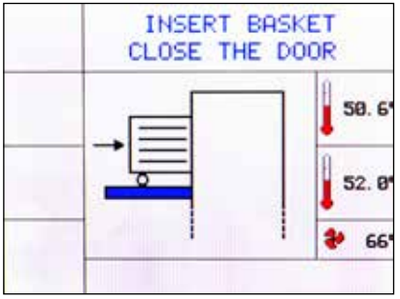 Once the machine has started, the display shows the screen indicating door open and the invitation to insert the basket with the instruments to be washed. Then insert the basket with the instruments and close the door. WARNING: The door must be tightly closed until you hear the classic closing «click», otherwise the program will not start.
Once the machine has started, the display shows the screen indicating door open and the invitation to insert the basket with the instruments to be washed. Then insert the basket with the instruments and close the door. WARNING: The door must be tightly closed until you hear the classic closing «click», otherwise the program will not start.
2- 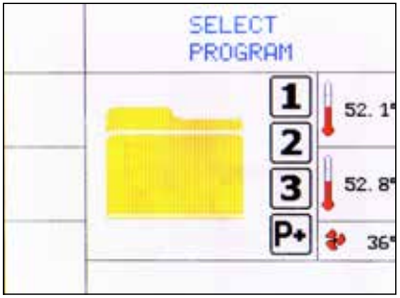 With the machine started and door closed, the screen for selecting the programs will appear. Press the selected key (1 or 2 or 3 Fig. 3) on the control panel. To access subsequent programs (if stored), press the «P+» several times;
With the machine started and door closed, the screen for selecting the programs will appear. Press the selected key (1 or 2 or 3 Fig. 3) on the control panel. To access subsequent programs (if stored), press the «P+» several times;
3- 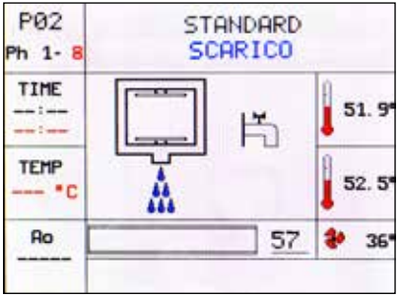 PHASE 1 – After pressing key 2 (STANDARD), press the START key (7 Fig. 12). With this operation the machine starts the automatic work cycle and discharges any residual water present in the tank.
PHASE 1 – After pressing key 2 (STANDARD), press the START key (7 Fig. 12). With this operation the machine starts the automatic work cycle and discharges any residual water present in the tank.
4- 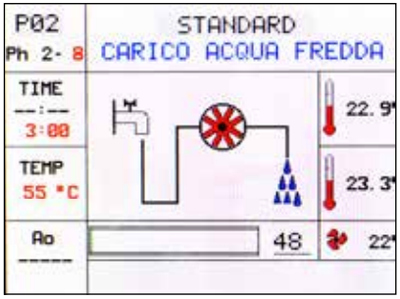 PHASE 2 – Self-loading of cold water. During the self-loading phase, the machine will bring the water temperature to 50°C and will maintain it for the washing time, 3 minutes.
PHASE 2 – Self-loading of cold water. During the self-loading phase, the machine will bring the water temperature to 50°C and will maintain it for the washing time, 3 minutes.
5- 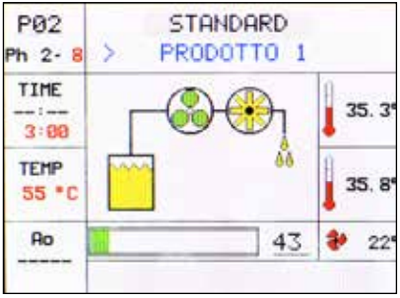 When the water reaches 35°C, the peristaltic pump will begin to inject the detergent liquid.
When the water reaches 35°C, the peristaltic pump will begin to inject the detergent liquid.
6- 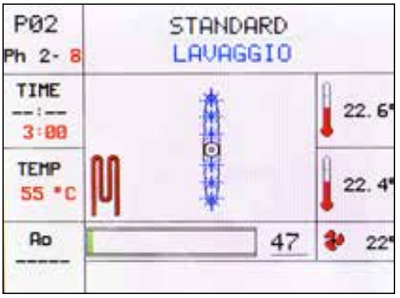 At this point the actual instrument washing phase begins.
At this point the actual instrument washing phase begins.
7- 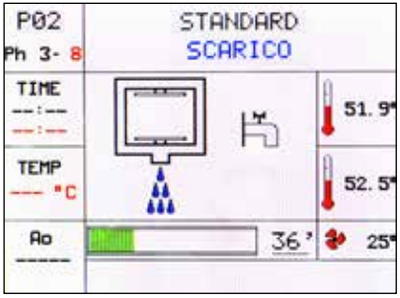 PHASE 3 – At the end of the washing operation, water and product used will be automatically discharged.
PHASE 3 – At the end of the washing operation, water and product used will be automatically discharged.
8- 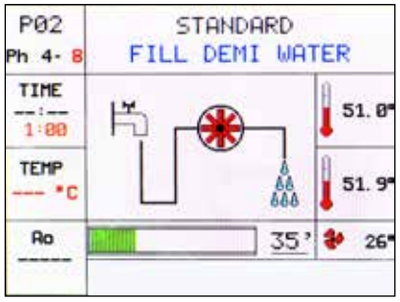 PHASE 4 – Purified water load. The use of purified water is necessary for rinsing the instruments and will last 20 seconds in order to eliminate foam and remnants of detergents.
PHASE 4 – Purified water load. The use of purified water is necessary for rinsing the instruments and will last 20 seconds in order to eliminate foam and remnants of detergents.
9- 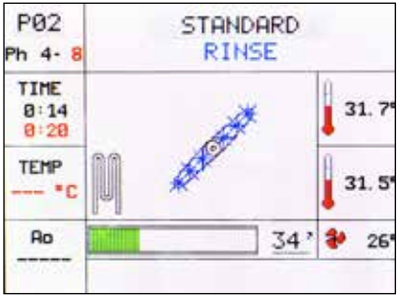 Rinsing of the instruments in purified water.
Rinsing of the instruments in purified water.
10- 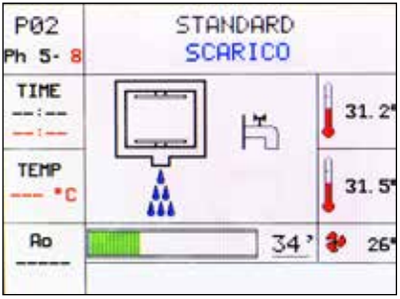 Phase 5 – Purified Water Unload
Phase 5 – Purified Water Unload
11- 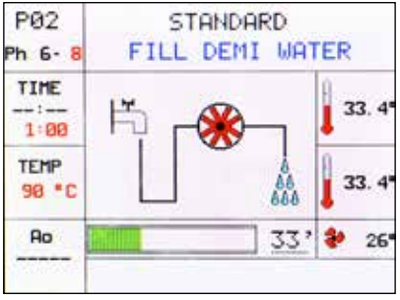 PHASE 6 – Loading of purified water for disinfection. The water will be brought to 90°C for the sterilization operation.
PHASE 6 – Loading of purified water for disinfection. The water will be brought to 90°C for the sterilization operation.
12- 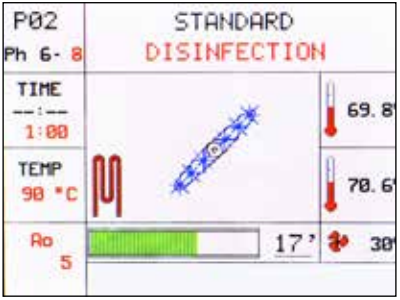 Instrument Disinfection
Instrument Disinfection
13- 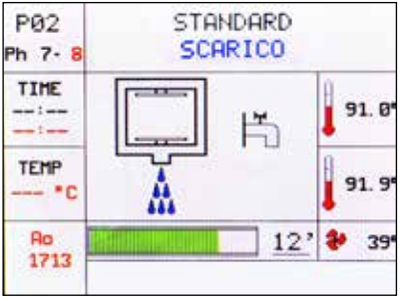 PHASE 7 – Purified water unload after disinfection
PHASE 7 – Purified water unload after disinfection
14- 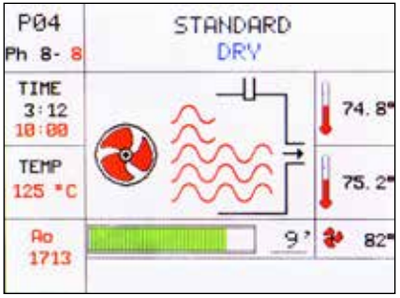 PHASE 8 – Drying of instruments with blown hot air
PHASE 8 – Drying of instruments with blown hot air
15- 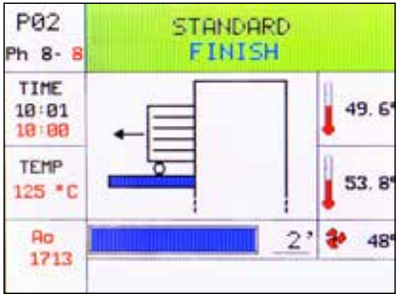 End of the “STANDARD” cycle. You can now open the door and remove the basket.
End of the “STANDARD” cycle. You can now open the door and remove the basket.
If, for any reason, it is necessary to interrupt the cycle, simply hold down the RESET key for a few seconds until an audible alarm (buzzer) is heard and an alarm screen appears on the display with the message: «WARNING. DISINFECTION CYCLE INTERRUPTED».
Once the problem is resolved, resume the cycle from the beginning. If the problem cannot be solved, please contact us for technical assistance.
Alarm Messages
The machine is equipped with an alarm system that indicates malfunctions detectable with an audible signal (buzzer) and with a screen on the graphic display of the control panel.
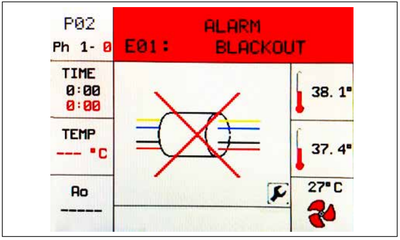 At first the image concerning the alarm is displayed (for 5 seconds); then the alarm description is displayed (for 10 seconds). The image and text alternate until the alarm is reset.
At first the image concerning the alarm is displayed (for 5 seconds); then the alarm description is displayed (for 10 seconds). The image and text alternate until the alarm is reset.
The alarms, description and possible solution are listed in the tables below.
| ALARM | DESCRIPTION | ACTION | |
|---|---|---|---|
| EO1: | BLACKOUT | Power failure during the cycle and the program blocked | Press RESET |
| EO2: | DOOR OPEN | The door is open or unlocked. Close it/ If it persists, please contact a technician. | Press RESET |
| EO2: | DOOR OPEN | Close it. | Press RESET If it persists, please contact a technician. |
| EO7: | NO DOOR LOCK | The door did not lock within the time preset. | Press RESET If it persists, please contact a technician. |
| EO9: | NO DOOR UNLOCK | The door did not lock within the time preset. | Press RESET If it persists, please contact a technician. |
| E11: | DIRTY WATER | Check for dirt residues on the load and check the purified water in the network. | Press RESET If it persists, please contact a technician. |
| E20: | NO COLD WATER | The cold water valve could be closed or partially open. Check it. | Press RESET If it persists, please contact a technician. |
| E21: | NO HOT WATER | The hot water valve could be closed or partially open. Check it. | Press RESET If it persists, please contact a technician. |
| E22: | NO DEMI WATER | The purified water valve could be closed or partially open. Check it. | Press RESET If it persists, please contact a technician. |
| E26: | PRINTER PAPER | The printer ran out of paper. Insert a new roll. | Press RESET If it persists, please contact a technician. |
| E30: | FLOWMETER 1 | Tank 1 of the chemical liquid could be empty. Check it. | Press RESET If it persists, please contact a technician. |
| E31: | FLOWMETER 2 | Tank 2 of the chemical liquid could be empty. Check it. | Press RESET If it persists, please contact a technician. |
| E32: | FLOWMETER 3 | Tank 3 of the chemical liquid could be empty. Check it. | Press RESET If it persists, please contact a technician. |
| E34: | PRODUCT TIMEOUT | The density of the chemical liquid could be too high. Checck. | Press RESET If it persists, please contact a technician. |
| E40: | RELAY RES. H20 | There is a problem with the contactor of the water heating elements. | Press RESET If it persists, please contact a technician. |
| E41: | DRAIN TIMEOUT | The drain pipe could be obstructed or crushed. Check it. | Press RESET If it persists, please contact a technician. |
| E42: | AIR PRESSURE | The air pump could be malfunctioning or there could be leaks of air in the ducts. | Press RESET If it persists, please contact a technician. |
| E43: | DRYING TEMP | The load may not be dry because the preset minimum temperature was not reached. | Press RESET If it persists, please contact a technician. |
| E44: | PRE-WASH TEMP | Too high of a temperature was detected during the pre-wash phase | Press RESET If it persists, please contact a technician. |
| E45: | TANK TEMP LIMIT | Too high of a temperature was detected in the tank | Press RESET If it persists, please contact a technician. |
| E46: | AIR TEMP LIMIT | Too high of an air temperature was detected | Press RESET If it persists, please contact a technician. |
| E47: | PHASE TEMP LIMIT | Too high of a temperature was detected during the phase in progress | Press RESET If it persists, please contact a technician. |
| E50: | PROBE 1 BROKEN | The PT1000-1 working probe (tank) could be faulty or disconnected. | Press RESET If it persists, please contact a technician. |
| E51: | PROBE 2 BROKEN | The PT1000-2 control probe (tank) could be faulty or disconnected. | Press RESET If it persists, please contact a technician. |
| E52: | AIR PROBE KO | The PT1000-3 probe (air) could be broken or disconnected. | Press RESET If it persists, please contact a technician. |
| E53: | TANK TEMP DIFF. | A temperature difference has been detected between the tank probes that is too high. | Press RESET If it persists, please contact a technician. |
| E62: | BUS CABLE | A faulty connection has been detected on the bus between the Micro-1 ad Micro-2 | Press RESET If it persists, please contact a technician. |
| E67: | CONDENSER L. | The water level in the steam condenser has reached the maximum level allowed. | Press RESET If it persists, please contact a technician. |
| E70: | PUMP PRESSURE | There may be water leaks. | Press RESET If it persists, please contact a technician. |
| E71: | HEPA FILTER | The HEPA filter could be dirty or obstructed. Check it. | Press RESET If it persists, please contact a technician. |
| E75: | PRODUCT 1 EMPTY | Tank 1 of chemical liquid is empty. Add Liquid. | Press RESET If it persists, please contact a technician. |
| E76: | PRODUCT 2 EMPTY | Tank 2 of chemical liquid is empty. Add Liquid. | Press RESET If it persists, please contact a technician. |
| E77: | PRODUCT 3 EMPTY | Tank 3 of chemical liquid is empty. Add Liquid. | Press RESET If it persists, please contact a technician. |
| E89: | NO DISINFECTION | The minimum value of A0 has not been reached and the load is still contaminated. | Press RESET If it persists, please contact a technician. |
| Warning | Description | Action |
|---|---|---|
| 1 RELOAD SALT BOWL | 1- Remove the basket 2- Loosent the salt bowl cap 3- Fill the salt bowl 4- Tighten the salt bowl cap | Press RESET for 5 seconds |
| 2 MAINTENANCE REQUEST | Contact customer service or the technician in charge of periodic maintenance | Press RESET |
| 3 VALIDATION REQUEST | Contact customer service or the technician in charge of periodic maintenance | Press RESET |
To see the Tuttnauer Tiva 2 you can visit the following:
See the Tuttnauer Tiva2 TD Washer Disinfector OEM 112002041→
See the Tuttnauer Tiva2-H TD Washer Disinfector OEM 112002042→
See all available Instrument Processing Products→
See all available Infection Control Products→
*All information for Tuttnauer TIVA2 operating instructions was taken from Tuttnauer Thermodisinfector TIVA2 TIVA2H – Man205-0717001EN – Edit. 1/2019
As always if you have any questions about this process or anything else please feel free to contact us and take advantage of our “FREE TECH SUPPORT.”
We also offer FREE VIRTUAL TECH SUPPORT to “See and Talk” with a “Real Time Live Technician” for any problems you may be in need of help with.
You can also use our “FREE MAINTENANCE PROGRAM”. Take the guesswork and worrying about what unit is due for maintenance and which maintenance cycle it is time for. We will keep track of all your autoclaves and let you know when it’s time for anything.
